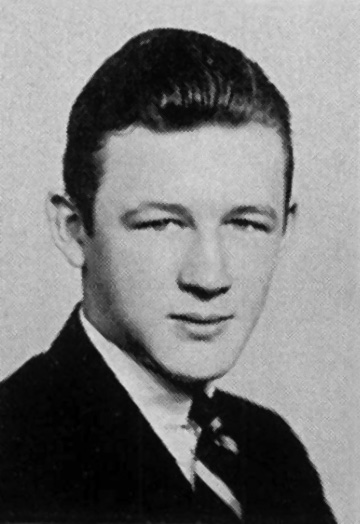Richard MacMillan “Mac” Ramseur was born at Lincolnton, Lincoln County, North Carolina on April 10, 1922. Apparently the original family surname was Ramsaur—his grandfather's name was Ramsaur, and his father signed his name Frederick Henry Ramsaur on his World War I draft registration—but the surname was recorded as Ramseur by 1940.
He was one of four children of Frederick Henry Ramseur (19 Jun 1887 – 12 May 1966), who was born at Lincolnton, North Carolina; and Mary McGeachy (MacMillan) Ramseur (28 Aug 1887 – 12 Nov 1968), who was born at Parkton, Robeson County, North Carolina. His parents married at Parkton, North Carolina on September 2, 1914, and set up household at Lincolnton, North Carolina, where his father was a hardware merchant. By 1939 the family moved to 9 Sumner Street in Greenville, South Carolina, where his father was manager of a cotton warehouse. In 1941–1942 the family lived at 1206 6th Street, Hickory, Catawba County, North Carolina. By 1943 the family lived at 4118 Kilbourne Road, Columbia, South Carolina. His parents' last residence was Camden, Kershaw County, South Carolina.
He graduated from Greenville High School, South Carolina in 1939. In 1939–1941 he attended Georgia Institute of Technology (Georgia Tech) in Atlanta, Georgia. In 1941–1942 he lived with his parents in Hickory, North Carolina, where he worked for a professor at Lenoir-Rhyne College. He registered for the Draft at Hickory on July 20, 1942. In 1942–1943 he attended North Carolina State College in Raleigh, North Carolina, where he was a Junior and studied Chemical Engineering. He was inducted into the U.S. Army on July 19, 1943.
He completed Army Air Forces radio operator and aerial gunery training, and was assigned to the heavy bomber crew of Lt George R. Kline Jr. The Kline crew completed operational training in the B-24 Liberator heavy bomber at Walla Walla, Washington in August–October 1944. On November 15, 1944, the crew embarked on RMS Aquitania at Jersey City, New Jersey for the Atlantic crossing. The ship arrived at Gourock, Scotland on November 21, 1944, and the Kline crew spent several days at the Army Air Forces Replacement Control Depot at Stone, Staffordshire, England. The crew was assigned to the 836th Bomb Squadron of the 487th Bomb Group at Army Air Forces Station 137 near the village of Lavenham, Suffolk, England. They arrived at Station 137 by November 26, 1944, and became part of the 8th U.S. Army Air Force in Europe. After a period of indoctrination, the crew made the transition to the B-17 Flying Fortress heavy bomber, which the 487th Bomb Group was flying at that time. Here is the crew roster upon arrival at Station 137:
836th Bomb Squadron, Crew #7
• George R. Kline Jr – Pilot
• Dale H. Parrish – Copilot
• Earl G. Coulter – Navigator
• Alan S. Rosenfeld – Bombardier
• Richard M. Ramseur – Radio Operator
• Robert M. MacLean – Engineer-Gunner
• Bert N. Smith – Armorer-Gunner
• Lanny B. Hammons – Gunner
• Franklin L. Underwood – Gunner
• Edward L. Evanich – Gunner
On December 30, 1944 the Kline crew flew its first combat mission to bomb the railroad marshalling yards at Mannheim, Germany. The crew's aircraft for this mission was B-17G 43-37911, and Lt James F. Day, an experienced pilot, took the place of Lt Kline. Sgt Ramseur died of anoxia on the return route. Tail gunner Edward Evanich wrote:
"1st Mission. Woke up at 4:30 a.m. Went to gunners briefing room and found out target was to be Mannheim, a marshalling yard. Got to the ship, installed guns. Took off at 8:45 a.m. Hit the target at 1:15 p.m. Ramseur, our radio man, came back to the tail. Hitched up on my right side oxygen systems and a little later I noticed that he wasn’t getting oxygen (the rubber diaphragm wasn’t working). Called Underwood, the waist gunner, to bring an emergency oxygen bottle. He came back and Ramseur motioned he was all right. Then called the bombardier [Lt Rosenfeld] to come to the tail and we tried to drag him out of the tail, but couldn’t. Gave him artificial respiration for 2 1/ 2 hours. He died of anoxia. Cleaned guns, interrogated, hit the sack at 11:00 p.m."
Sgt Ramseur is buried at Cambridge American Cemetery near Madingley, England. He also has a memorial marker at Quaker Cemetery in Camden, Kershaw County, South Carolina, where his parents are buried.
Source of information: Paul M. Webber, www.findagrave.com

